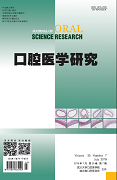|
|
Effects of Tobacco Extract on TLR4 Inflammatory Pathway in Periodontal Tissues of Mice with Periodontitis
WU Yunfei, ZHANG Li, ZHANG Xufeng, FU Qiya
2019, 35(7):
651-656.
DOI: 10.13701/j.cnki.kqyxyj.2019.07.009
Objective: To explore the effects of tobacco extract on Toll-like receptor 4 (TLR4) inflammatory pathway in periodontal tissues of mice with periodontitis. Methods: Rats were randomly divided into control group, model group, low, medium, and high dose groups. Micro-CT scan was used to observe periodontal bone changes. The levels of tumor necrosis factor-α (TNF-α), interleukin-1β (IL-1β), and interleukin-6 (IL-6) in serum were detected by enzyme-linked immunoassay (Elisa). HE staining was used to detect the pathomorphological changes of periodontal tissues. The expressions of TLR4, tumor necrosis factor receptor related factor 6 (TRAF6), and nuclear factor κB (NF-κB) in periodontal tissues were detected by real-time fluorescence quantitative PCR (qRT-PCR), immunoblotting (WB), and immunohistochemistry. Results: Bone volume ratio, bone surface area ratio, and trabecular thickness in model group were significantly decreased, trabecular space was increased, serum levels of TNF-α, IL-1β, IL-6, expression of TLR4, TRAF6, and NF-κB in periodontal tissue were significantly increased (P<0.05). Compared with the model group, the bone volume ratio, bone surface area ratio, trabecular thickness, trabecular space, serum levels of TNF-α, IL-1β, IL-6, expression of TLR4, TRAF6 and NF-κB in periodontal tissues of the tobacco extract groups were significantly increased (P<0.05). Conclusion: Tobacco extract can aggravate periodontal tissue inflammatory reaction in mice with periodontitis, which may be related to up-regulation of TLR4 signaling pathway in periodontal tissue.
References |
Related Articles |
Metrics
|

